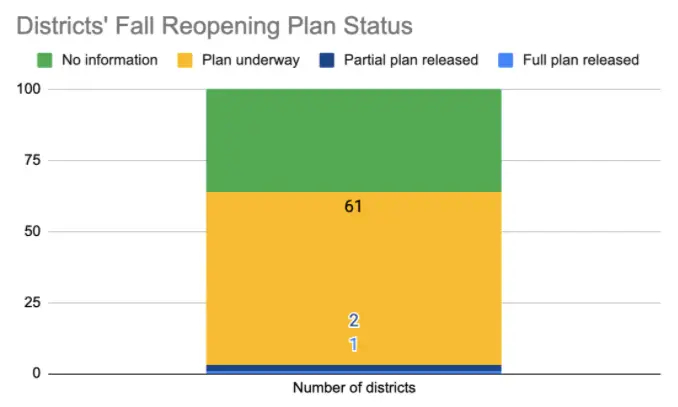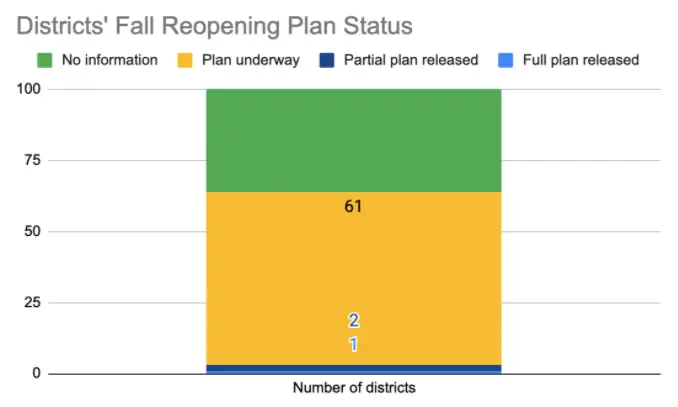Parents, students, teachers, policymakers, and community members are all waiting for schools to release fall reopening plans. Four months into COVID-19, and just weeks out from the new school year, very few districts in our database report concrete expectations for the 2020-21 school year.
CRPE has been watching for reopening plans for the 100 districts and 18 CMOs in our database, but just a handful of districts have released detailed plans. While we wait for more detail, we can share some broad strokes about district preparations for the fall. We will return with a deeper analysis of district and state reopening plans as soon as more information is released.
Most districts are in the planning stages and seeking input from the community.
Of the 100 districts we reviewed, only Detroit Public Schools has produced a formal fall reopening plan that includes information about teaching and learning, as well as health and safety. Two others—Clark County and Metro Nashville Public Schools—have produced formal plans that address health and safety concerns for resuming in-person instruction.
Most other districts we reviewed (61 of 100) share that they are in a planning process, with most aiming to release plans in early July. The remaining 36 have not provided any information on a planning process.
Nearly half (49 of 100) of the districts have engaged their community by asking for public input on their plans, usually through online parent surveys. Other forms of engagement include focus groups and public school board working sessions.
Districts are largely silent about what to expect in 2020-21.
Just 23 districts have provided information about what school might look like in the fall: in-person, remote, or a hybrid model that combines the two.
Only two districts—Anchorage School District and Henry County Public Schools—have provided information about the learning loss assessment they will use. Six districts offer information on planned interventions to catch students up in the fall, and five districts will start school early, presumably to add instructional time for the 2020-21 school year.
Districts provide similarly little information about how they will address remote learning in a virtual or hybrid environment. Eight have provided information on device provision to families in the fall. Just six, so far, will provide parent training materials, and nine have communicated plans for teacher professional development.
It’s clear that districts are working behind the scenes to gather information from families and to plan scenarios. They may be waiting to make formal commitments until they receive more information from state departments of education, public health agencies, or their own communities. Districts must juggle the logistical challenge of preparing for remote learning scenarios and the possibility of in-person learning in the face of public health concerns and gaps in internet access.
But these challenges must not detract from the most important bottom line for any school system: student learning, which likely suffered during the spring’s interruptions, hitting younger and more vulnerable students the hardest.
How well districts set clear expectations, anticipate and solve problems, and strategically deploy resources will determine whether schools allow learning gaps between students to grow wider. School systems have the opportunity to build learning systems that are more equitable than the ones they rapidly pulled together this past spring, but careful planning will be critical.
We are concerned that school systems are not yet communicating how they will address the negative impact of instruction many students missed during this spring’s school closures, but we hope to be able to report more details soon.







